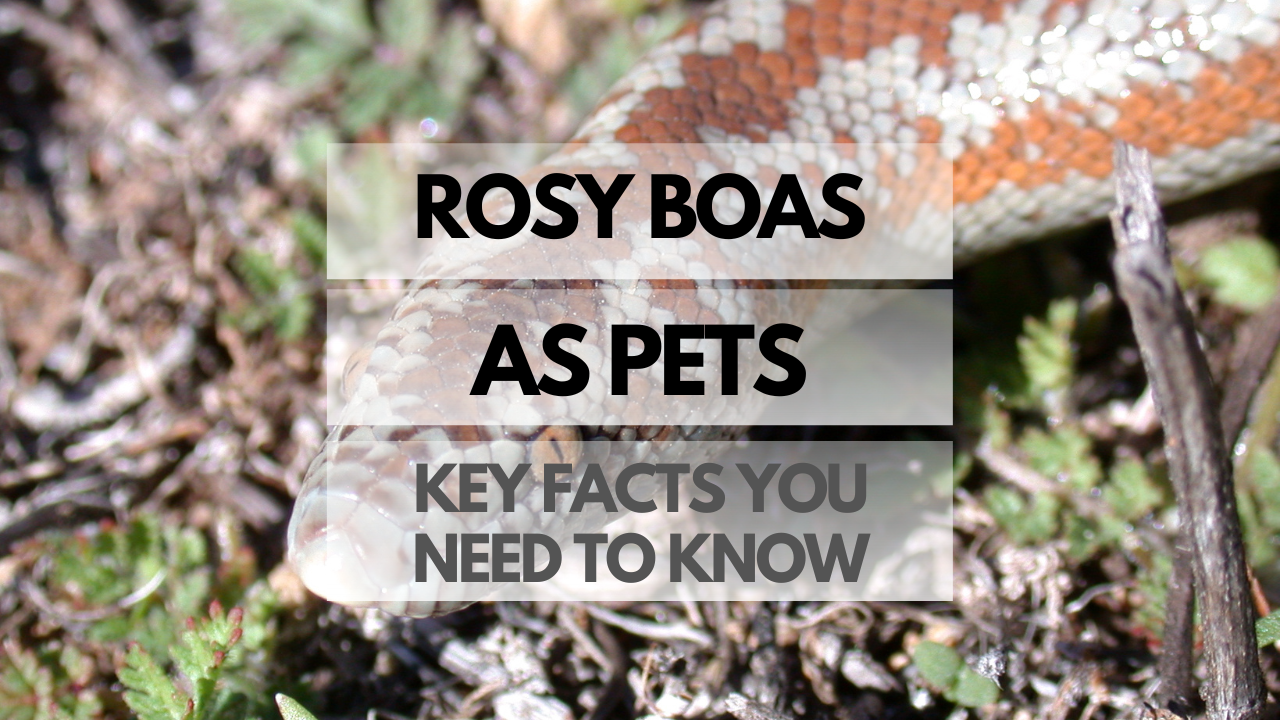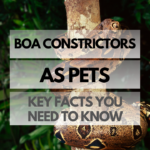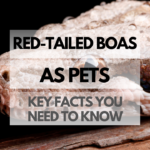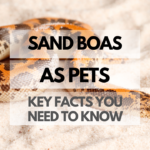Rosy Boas are small, docile snakes that have become increasingly popular as pets due to their easy care requirements and friendly nature. Native to the southwestern United States and northwestern Mexico, these snakes have been capturing the hearts of reptile enthusiasts for decades. In this article, we’ll delve into the fascinating world of Rosy Boas, exploring their unique characteristics, behaviors, and care requirements.
Quick Reference Table: Rosy Boa Facts
| Scientific Name | Adult Size | Lifespan | Diet | Behavior | Habitat |
|---|---|---|---|---|---|
| Lichanura trivirgata | 24-36 inches (61-91 cm) | 15-25 years | Carnivorous (small rodents) | Docile, friendly | Desert, arid regions |
How Are Rosy Boas as Pets?
Rosy Boas make excellent pets for both beginners and experienced snake keepers. They are generally docile, easy to handle, and have relatively simple care requirements. Their small size and attractive appearance also make them a popular choice for pet owners with limited space.
Pros and Cons of Rosy Boas
Pros:
- Small size, suitable for limited space
- Docile and easy to handle
- Low maintenance and easy-care requirements
- Long lifespan
Cons:
- May require live or frozen prey
- Not suitable for those with rodent allergies
- May require additional heat sources in cooler climates
Rosy Boa Behavior and Temperament
Rosy Boas are known for their docile and friendly behavior. They are generally easy to handle and rarely display aggression. These snakes are also relatively inactive, making them a manageable pet for those who are less experienced with reptiles.
How Much Do Rosy Boas Cost?
Rosy Boas can typically be purchased for $75-$200, depending on the species and coloration. Initial setup costs for a suitable habitat can range from $100-$300, and ongoing expenses include food, substrate, and heating equipment.
Rosy Boa Lifespan: Time and Commitment
Rosy Boas have a lifespan of 15-25 years in captivity, making them a long-term commitment for pet owners. Regular handling and proper care can help ensure a happy, healthy relationship with your Rosy Boa for years to come.
Rosy Boa Size
Adult Rosy Boas typically reach a length of 24-36 inches (61-91 cm), making them a small and manageable snake species.
Rosy Boa Species
There are currently three recognized subspecies of Rosy Boas:
Lichanura trivirgata trivirgata (Coastal Rosy Boa)
This subspecies is found along the California coast and Baja California, Mexico. Coastal Rosy Boas have a more vibrant coloration, with bold orange or red stripes on a gray or brown background.
Lichanura trivirgata gracia (Desert Rosy Boa)
Desert Rosy Boas inhabit arid regions of southeastern California, southwestern Arizona, and Mexico. They exhibit more subdued coloration, with pale gray or beige stripes on a light background.
Lichanura trivirgata roseofusca (Mexican Rosy Boa)
Found in northwestern Mexico, the Mexican Rosy Boa displays a variety of colors and patterns, with some individuals exhibiting a pinkish hue.
Rosy Boa Colors, Looks, and Appearances
Rosy Boas are known for their attractive coloration, which includes a range of hues such as orange, red, gray, beige, and pink. Their pattern typically consists of three longitudinal stripes running down the lengthof their body, with the central stripe being the most vibrant.
Rosy Boa Care Guide
Proper care for your Rosy Boa is essential to ensure a long, healthy life. This includes providing an appropriate habitat, maintaining ideal environmental conditions, and offering a suitable diet.
Rosy Boa Habitat: Tank and Housing
Creating a comfortable and secure environment for your Rosy Boa is crucial for their wellbeing. This includes selecting the right enclosure, setting up appropriate heating and lighting, and providing suitable furnishings and decorations.
Appropriate Rosy Boa Tank Size
A 20-gallon long tank is recommended for adult Rosy Boas, while a 10-gallon tank is suitable for juveniles. Ensure the enclosure has a secure lid to prevent escapes.
Types of Enclosures
Glass terrariums, plastic tubs, and PVC enclosures are all suitable options for housing a Rosy Boa. The choice will depend on your preferences and budget.
Substrate Options
Aspen shavings, coconut coir, and cypress mulch are all appropriate substrates for Rosy Boas. Avoid using sand, cedar, or pine, as these can cause health issues.
Heating and Lighting Requirements
Rosy Boas require a temperature gradient within their enclosure, with a basking spot of 85-90°F (29-32°C) and a cooler area ranging from 70-75°F (21-24°C). A heat mat or ceramic heat emitter can be used to maintain these temperatures. UVB lighting is not necessary for Rosy Boas, but a 12-hour light cycle should be maintained using a low-wattage LED or fluorescent bulb.
Humidity and Temperature Control
Rosy Boas thrive in low humidity environments, with a relative humidity of 30-50%. A digital thermometer and hygrometer can help you monitor and maintain these conditions in your snake’s enclosure.
Furnishings and Decorations
Provide your Rosy Boa with hiding spots, such as cork bark or commercial hide boxes, as well as climbing branches or artificial plants for enrichment. Ensure there is a water dish available for drinking and soaking.
Cleaning and Maintenance
Regular cleaning is important for maintaining a healthy environment for your Rosy Boa. Spot clean the enclosure daily by removing feces and soiled substrate, and perform a complete substrate change and enclosure cleaning every 4-6 weeks. Don’t forget to sanitize the water dish and decor items during the full cleaning process.
Rosy Boa Food: Diet and Nutrition
Providing a balanced and nutritious diet is essential for the health and well-being of your Rosy Boa. In this section, we’ll discuss their dietary needs, feeding schedules, and more.
Feeding Frequency and Schedule
Juvenile Rosy Boas should be fed every 5-7 days, while adult Rosy Boas can be fed every 10-14 days. Adjust the feeding schedule based on your snake’s activity level, size, and overall health.
What do Rosy Boas Eat?
Rosy Boas are carnivorous and primarily feed on small rodents, such as mice and young rats. Frozen-thawed prey is recommended for safety and convenience, but some snakes may prefer live prey.
Rosy Boa Treats
While rodents are the primary diet for Rosy Boas, occasional treats like small quail chicks can provide variety and enrichment for your snake. Always feed appropriately sized treats to avoid choking or digestive issues.
Foods to Avoid
Never feed your Rosy Boa insects, fruits, vegetables, or other inappropriate foods. Stick to a diet of rodents and occasional small bird chicks to ensure proper nutrition.
Supplements and Vitamins
Rosy Boas do not generally require additional supplements or vitamins if they are fed a proper diet of whole prey items. Consult with a reptile veterinarian if you have concerns about your snake’s nutritional needs.
Hydration
Provide fresh, clean water for your Rosy Boa at all times. A shallow water dish should be available for drinking and occasional soaking.
Handling and Socialization
Regular handling and socialization are important for building trust and maintaining a positive relationship with your Rosy Boa. In this section, we’ll discuss taming, safe handling techniques, and more.
Taming and Bonding
Begin handling your Rosy Boa gently and gradually to build trust. Start with short, frequent sessions and gradually increase the duration as your snake becomes more comfortable. Be patient and consistent, as taming can take time.
Safe Handling Techniques
When handling your Rosy Boa, always support its body and avoid sudden movements. Never handle your snake by the tail or head, as this can cause stress or injury. Wash your hands before and after handling to minimize the risk of disease transmission.
Signs of Stress and Illness
Monitor your Rosy Boa for signs of stress or illness, such as lethargy, refusal to eat, or unusual behavior. If you notice any concerning symptoms, consult with a reptile veterinarian.
Introducing Rosy Boas to Other Pets
Exercise caution when introducing a Rosy Boa to other pets, as some animals may view the snake as prey or a threat. Always supervise interactions and ensure your snake has access to a secure, stress-free environment.
Health and Wellness
Proper care and attention to your Rosy Boa’s health are essential for a long, happy life. In this section, we’ll discuss common health issues, preventative care, and more.
Common Health Issues
Rosy Boas can be prone to respiratory infections, mites, and digestive issues. Maintain proper husbandry and monitor your snake for any signs of illness. Consult with a reptile veterinarian if you have concerns about your snake’s health.
Signs of a Healthy Rosy Boa
A healthy Rosy Boa should have clear eyes, smooth skin, a strong appetite, and regular bowel movements. They should also be alert and responsive to their environment.
Preventative Care
Regular enclosure cleaning, proper temperature and humidity control, and a well-balanced diet are all essential components of preventative care for your Rosy Boa. Ensure your snake has access to clean water and a stress-free environment.
Finding a Reptile Veterinarian
It’s important to find a qualified reptile veterinarian to help you care for your Rosy Boa. Look for a vet with experience treating snakes and ask for recommendations from fellow reptile enthusiasts if needed.
Breeding and Reproduction
Rosy Boas are ovoviviparous, meaning they give birth to live young. In this section, we’ll cover topics related to breeding and reproduction,including gender determination, courtship, and caring for hatchlings.
Determining Gender
Sexing a Rosy Boa can be challenging, especially for inexperienced keepers. It’s best to consult with a qualified reptile veterinarian or experienced breeder for assistance in determining the gender of your snake.
Mating Behavior and Courtship
Rosy Boas typically mate in the spring. During courtship, males will search for females and engage in rubbing and tactile behaviors to stimulate the female. Ensure both snakes are healthy and of appropriate age before attempting to breed.
Gravidity and Egg-laying
Rosy Boas give birth to live young, so they do not lay eggs. Instead, females will become gravid (pregnant) and carry the developing embryos inside their bodies. Gravid females should be provided with a suitable nesting area and monitored closely for any signs of complications.
Incubation and Hatching
As live-bearers, Rosy Boas do not have an incubation period. Instead, the female will give birth to live, fully-formed baby snakes after a gestation period of approximately 4-5 months.
Caring for Hatchlings
After giving birth, Rosy Boa hatchlings are independent and do not require parental care. Provide the hatchlings with their own separate enclosures with appropriate heat, humidity, and hiding spots. Begin feeding the young snakes with small, appropriately sized prey items.
Are Rosy Boas Legal?
Before acquiring a Rosy Boa, it’s essential to check your local laws and regulations regarding the ownership of exotic pets. Some states or municipalities may have restrictions or requirements, such as permits or licensing, for keeping Rosy Boas.
Popular Names for Rosy Boas
Choosing a fun and interesting name for your Rosy Boa is part of the excitement of owning one of these unique pets. Here’s a list of some popular names:
- Rosie
- Ruby
- Boa Constrictor
- Slinky
- Stripes
- Serpico
- Rosetta
- Boadicea
- Rosco
- Houdini
Conclusion: Should You Own Rosy Boas as Pets?
Rosy Boas make fascinating and rewarding pets for those who are prepared to provide proper care and attention. It’s essential to research and understand the husbandry requirements, dietary needs, and health concerns unique to these snakes before committing to ownership. With patience, dedication, and responsible care, owning a Rosy Boa can bring you years of enjoyment and companionship.
FAQ for Pet Rosy Boas
- Q: Are Rosy Boas good pets?
- A: Yes, Rosy Boas can make great pets for those who are prepared to provide proper care and attention. They are relatively low-maintenance, docile, and have moderate size, making them suitable for reptile enthusiasts.
- Q: Can Rosy Boas eat grapes, bananas, strawberries, apples, spinach, tomatoes, carrots, cucumbers, watermelon, broccoli, blueberries, celery, cabbage, cilantro, kale, blackberries, oranges, avocados, corn, or asparagus?
- A: No, Rosy Boas are strictly carnivorous and should not be fed any fruits or vegetables. Their diet should consist of appropriately sized rodents or small bird chicks.
- Q: How often do Rosy Boas eat?
- A: Juvenile Rosy Boas should be fed every 5-7 days, while adult Rosy Boas can be fed every 10-14 days. Feeding frequency may vary depending on the snake’s size, activity level, and overall health.
- Q: How long do Rosy Boas live?
- A: With proper care, Rosy Boas can live up to 20-30 years in captivity.
- Q: Where are Rosy Boas native?
- A: Rosy Boas are native to the southwestern United States and northwestern Mexico, inhabiting arid and semi-arid regions.
- Q: Are Rosy Boas friendly?
- A: Yes, Rosy Boas are generally docile and can become quite friendly with regular handling and socialization.
- Q: Do Rosy Boas bite?
- A: While Rosy Boas are generally docile, any snake may bite if it feels threatened or stressed. Proper handling techniques and understanding snake behavior can minimize the risk of bites.
- Q: Do Rosy Boas like to be held?
- A: Rosy Boas can tolerate and even enjoy handling when they are accustomed to it. Regular, gentle handling can help build trust and a positive relationship between you and your snake.
- Q: Are Rosy Boas nocturnal?
- A: Rosy Boas are primarily nocturnal, which means they are most active during the night. However, they may also exhibit some activity during the day, especially in cooler temperatures.
- Q: Do Rosy Boas pee?
- A: Yes, Rosy Boas excrete both solid waste and liquid waste (urates) through their cloaca.
- Q: Do Rosy Boas hibernate?
- A: Rosy Boas undergo a period of brumation, which is similar to hibernation, during cooler months in the wild. In captivity, brumation is not necessary but may still occur if temperatures drop significantly.
- Q: Do Rosy Boas make noise?
- A: Rosy Boas are generally quiet animals, but they may hiss if they feel threatened or stressed.
- Q: Are Rosy Boas venomous or poisonous?
- A: No, Rosy Boas are non-venomous and pose no risk of venomous bites or poisoning.
- Q: Are Rosy Boas smart?
- A: Rosy Boas, like other snakes, have a basic level of intelligence and can learn to recognize their keepers and tolerate handling. However, their cognitive abilities are limited compared to more intelligent animals like mammals and birds.
- Q: Do Rosy Boas need heat at night?
- A: Yes, Rosy Boas require a consistent temperature gradient in their enclosure, which includes a cooler and a warmer side. Nighttime temperatures should be slightly cooler than daytime temperatures but still within the appropriate range for their species.
- Q: Do Rosy Boas lay eggs?
- A: No, Rosy Boas are ovoviviparous, meaning they give birth to live young rather than laying eggs.
- Q: Do Rosy Boas smell?
- A: Rosy Boas themselves do not have a strong odor, but their enclosures can develop an unpleasant smell if not cleaned regularly. Proper enclosure maintenance, including regular cleaning and wasteremoval, can help keep any smells to a minimum.




